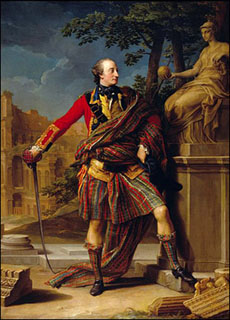Colonel the Honourable William Gordon knows full well that he is a damn fine figure of a man. The epitome of the noble Scotsman in
Gordon himself poses like a living statue. His costumier has ensured that he is a one-man riot of colour. Over red, gold and blue he wears great swathes of his clan’s Huntly Tartan, recreated in silk rather than heavy woollen cloth by an ingenious Roman tailor, so that it might be worn without discomfort in the heat of of the Italian sun. The fabric kilts him and swags him and follows behind him like a bride’s train; he even wears matching Huntly tartan leggings. He rests his left hand nonchalantly on his left hip, while in his right he holds a splendidly hilted sword, its tip pointing into the dusty ground. Gordon looks like a man who has conquered
Pompeo Batoni was the painter principally responsible for passing down the exquisite arrogance of Gordon, and a host of other British Grand Tourists, to posterity. Known in his own lifetime as “the painter of princes, and the prince of painters”, his reputation has fallen somewhat during the intervening centuries. It...


